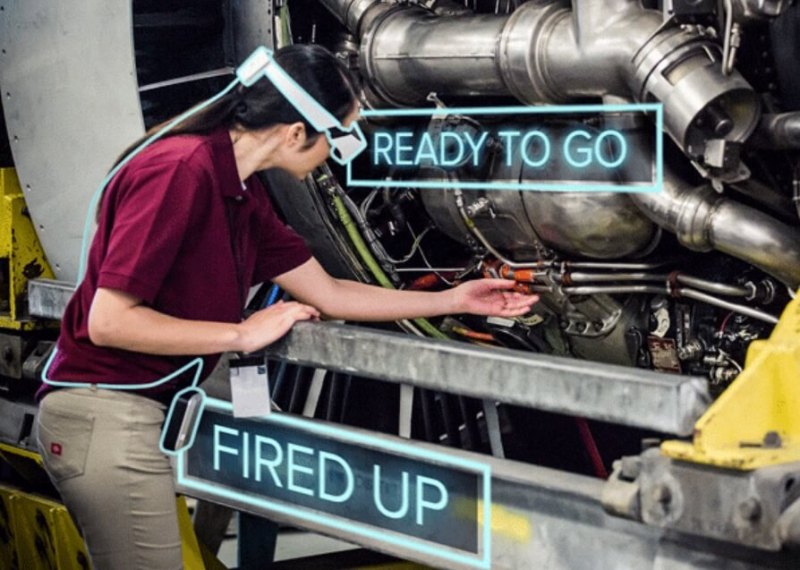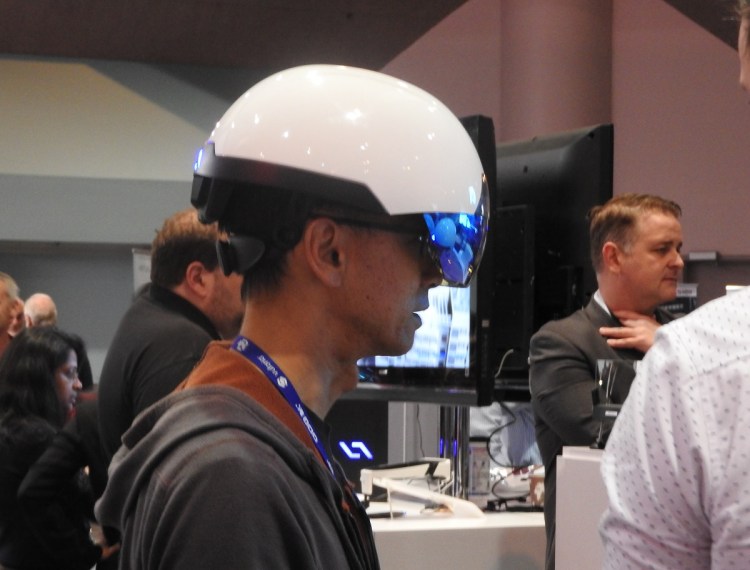Brian Mullins, CEO of Daqri, has been obsessed with augmented reality technology for many years. And now AR has finally grown up.
We could see that at Augmented World Expo this week in Santa Clara, Calif., where all the major tech companies — Google, Intel, Qualcomm, Microsoft — and many others had augmented reality technology on display. The event drew more than 4,700 people, compared to 3,850 a year ago and just 200 about seven years ago. It also drew 212 companies, compared to 120 last year.
Daqri showed its smart AR helmet for industrial uses, a heads-up display for cars, and its own pair of smart glasses for enterprises. I met with Mullins there to talk about how far the tech has come and how far it may have to go.
We talked about the company’s smart helmet, its heads-up display for cars, and why it hired Seamus Blackley, co-creator of the Xbox, and acquired Blackley’s research lab to commercialize an interesting new 3D printing technology dubbed “software defined light.” Mullins is intrigued about what Apple might announce in AR and how the technology could fundamentally change how we interact with the real world.
“We spent a lot of time talking about what it could do, showing what it could do. Now, okay, how do we get it in everyone’s hands? How do we scale it?” he said.
Here’s an edited transcript of our interview.

Above: Brian Mullins, CEO of augmented reality helmet maker Daqri.
VB: You’ve watched the space develop for a long time and seen progress. How do you feel about the pace of change and how the tech is catching up with what everybody wants?
Mullins: It’s the seventh year I’ve come to the show. To see it grow up from a couple hundred people to today — all the main players, not just in AR, but in technology are represented. The discussion is going beyond “What could it do?” and “When will it be valuable?” to “We’ve proven that this helps workers learn faster, retain more, reduce costs. We can demonstrate the ROI. How are we going to deploy it at scale? How do we connect it to the IT organization?” Everything from device management software to creative workflows with products like CAD systems…how are these customers going to buy thousands of units? How do we fulfill that? All the questions an industry needs to address in order to turn the corner and ramp and address demand.
That’s the phase AR is in right now. We spent a lot of time talking about what it could do, showing what it could do. Now, okay, how do we get it in everyone’s hands? How do we scale it? Some of that is — we can’t expect enterprise customers to look at AR and say, “I’ll adapt my business to this.” We have to adapt the way we sell AR and make products to those enterprises, to what they need to deploy for their workforces.
It’s an exciting shift to see the conversations change, to see the players here. Our partnership with Dell — that’ll open us up to a large channel of people who have historically been interested in AR and now have a way to buy it and roll it out.
VB: How did you approach separating out what’s cool about AR and what actually helps people solve a problem?
Mullins: When you have something that’s cool and could solve a lot of problems, you run the risk of making something that excites people but doesn’t really have a use. There’s a lot to learn there about focusing on a minimum viable product or minimum viable platform that could create AR products that pay for themselves, that meet ROI needs and can be used for other things as well.
It turns out that the advantage is it works well to help people learn things. You can learn faster than with any other form of training. This is proven in independent studies. Just having it isn’t enough. You have to wrap it in a solution. You have to connect it with things like 360 from Autodesk or Teamcenter from Siemens, so these content workflows that our customers have invested in are available in the AR right away. We’ve been able to make those connections and deliver a product that can create the ROI today.
It’s like looking at the screen on an early iPhone. Today you look at an iPhone and think, “That’s what a smartphone should be.” But if Apple waited to make that, it would have been a waste. You could make the industry out of the first iPhone and let it grow up. That’s where AR is today. Some people think they have to wait until the end state, but it’s ready today to solve problems and create value. Let’s get it in customers’ hands and iterate on future versions and continue to evolve the product.

Above: Daqri is creating augmented reality headsets and helmets.
VB: We had a panel of AR creators at our GamesBeat summit talking about all the different futures they foresee. What do you see in the future around things like displays? John Underkoffler’s company is making use of very big displays. Some people say that displays will go away entirely with good enough images on a pair of glasses.
Mullins: Certain types of displays you don’t need, but experiences will change to support it. Mimicking a display in AR will probably never be as good as a physical display. However, the benefit of it being virtualized could outweigh that, and the perceptible differences can be smoothed out. The question is, if I can have anything I want in real space, would I want it to look like a display, or do I change it completely into something more intuitive? Do I have a screen with an email icon and a little notification on it, or do I have a 3D model of a piece of mail sitting in front of me? I can physically intuit certain things by seeing a 3D model.
We won’t necessarily virtualize every screen, but it’ll affect where we need them. You’ll see new types of display technologies that are embedded. You’ll be able to interact with them seamlessly. You won’t always have a pair of AR glasses on. You get in the car and take them off, the car picks up. When I go home and settle in my living room, maybe there’s a different type of retinal projector installed there that makes it so I don’t need glasses or a physical screen to have an AR experience. That’s down the road, but it’s important to think about those modalities if you’re talking about a post-screen world.
VB: Intel was talking about how we’ll have a passenger economy arrive once we have self-driving cars. It’s another opportunity for displays.
Mullins: Absolutely. For a pretty good percentage of the population, when you look down at a screen while you’re in a car you get sick. One of the only ways to remove that sensation is to use AR in the car, so the screens are there but the content registers to the real world. Your sense of balance can interact with this content out there and not cause motion sickness. That’s where AR is going to bridge the gap in situations like that. You look at the HUD in a car today, the opportunity of putting content on windscreens or side windows, and then you think about when this car drives itself. The average American commuter spends 43 minutes on the road every day. That’s a valuable amount of time to interact with technology.

Above: Daqri’s helmet
VB: If you’re not driving, maybe you want to spend even longer in the car.
Mullins: Maybe. If you’re getting work done or enjoying interactive time, maybe you don’t have to think about living 20 minutes from the office. Maybe it opens up new places to live. If the freeways are less crowded because the cars are better at balancing the traffic, maybe we redesign how we build certain cities.
VB: What do you think of where everyone else is in the AR industry, how much progress is being made?
Mullins: We’re excited about our smart product line: the smart helmet for industrial field workers and the smart glasses for enterprise workers and the smart HUD in cars. It’s opening up to a larger market. The show floor isn’t open yet, but it’s always a great side-by-side to see all the devices and try them on. We’re learning a lot. The industry is learning a lot — what you need, what the important specs are. It’s about experience.
Translating from old displays and other methodologies hasn’t always worked right. Everyone is driving toward a more vertical field of view, but the real question is, what’s the field of view that’s not distorted? The distortion creeps up very quickly in different types of displays. If you have that, it’s not useful. Just having wider fields of view isn’t necessarily the goal. You need to focus on distortion and contrast and visibility in sunlight so you can use it anywhere.
We’re starting to adopt ways of talking about things and designing products to make sure they’re valuable to customers. But there’s a long way to go.
VB: Do you hope Apple can impact the industry in a good way?
Mullins: I’m hoping all the major mobile platforms will have a positive impact. We play in an enterprise space. We don’t think AR is one size fits all. A lot of the environments and customer needs are always going to require specialization to address them. It’s a long time before you see a mass adoption of a consumer product at a price point that does what people need it to do.
But you look beyond that — at what point is it also so good that you can take it to work? You’re talking about a 10-year proposition there, much like the way mobile phones grew up. They started as briefcases and bricks. They went into your car, and your car phone was amortized over the life of the vehicle. Ultimately, that built an infrastructure and people started to get personal phones. Then we had the smartphone and now everybody’s got one, but it took decades. It felt like overnight everybody had a smartphone, but no. It’s not going away overnight either. It won’t be replaced right away by a pair of glasses. The promises being made by some companies going after the consumer space won’t be realized at the price points.
If you look at the VR industry, they’re setting a very high bar for content. That’s good for the industry in general, but it makes it a moving target to some extent. As you start to see triple-A game titles roll out in VR — one or two this year, and more next year — that’s going to drive more adoption. VR will become more comfortable and consumers will have expectations of it. That’ll inform what consumer AR becomes. You’ll finally get to the devices consumers need over the next three to five years. Then you have to drive adoption on top of that. It’s exciting, but it’s a long road ahead.

Above: Daqri is also working on augmented reality heads-up displays for cars.
VB: Are you interested in some of the talks coming up here? The Vuforia guys had something interesting on Project Chalk, annotating things in AR.
Mullins: With AR and computer vision, a lot of these things are going to start to become native. You asked me about what Apple will do for AR. It’ll build in computer vision and additional sensors directly into the hardware. To access AR, it’ll be natively in the Apple tools. It’ll be done partially in hardware, so it’ll be better than third-party software running on an iPhone.
That’ll change the developer ecosystem quite a bit. You won’t necessarily need to go through a tool like Unity and export through an AR library to iOS or Android or another platform. You’ll go Unity directly to native, whether it’s Tango or something in iOS. It doesn’t necessarily impact on the enterprise the same way, but you’ll start to see where those capabilities are done better in hardware than in software. Then developers won’t necessarily have to use third-party tools to wrap them up.
VB: In your long-term, then, you might focus on making sure you can do cool software applications, as opposed to being a hardware company?
Mullins: From our perspective, making the helmets and glasses and automotive components — we’re in a different customer base, but we have the same technology road map as someone like an Apple for cell phones, and perhaps someday wearable devices. We’re doing that today, where our computer vision and mapping are all at the hardware level too. You don’t need any third-party wrappers to work on a Daqri platform. That’s important.
VB: If the hardware gets produced at some point by all the big companies, though, and they provide a base platform, do you design your products for that platform instead of designing separate pieces of hardware?
Mullins: If you look at our automotive customers today, they make the car. They license the technology for the HUD in it. That’s something Daqri does, providing the flexibility to work with customers to get technology in their products. There will be a lot of uses of AR outside of mobile phones and outside of just consumer wearable devices that we see facilitating for people integrating AR into other applications.
VB: So the smartphone isn’t the one and only thing that exists in this future. I suppose if you have AR, at some point the smartphone doesn’t need to exist.
Mullins: That’s a real question. When you look at historically — Apple enters a space when it’s established. They’ll do what they do. Others will try to get in, but whether a cell phone company can adapt to become an AR company — you saw a lot of players that were established in tech that didn’t necessarily make the leap to mobile. They missed it.
The landscape is very different. There will be a lot of uses in enterprise, and a lot of established tech players that make devices — whether it’s phones or computers today — will try to get into the space. But they’ll face the same transition hurdles they faced with getting into smartphones. Some of them did a great job of it and others ended up leaving the space.

